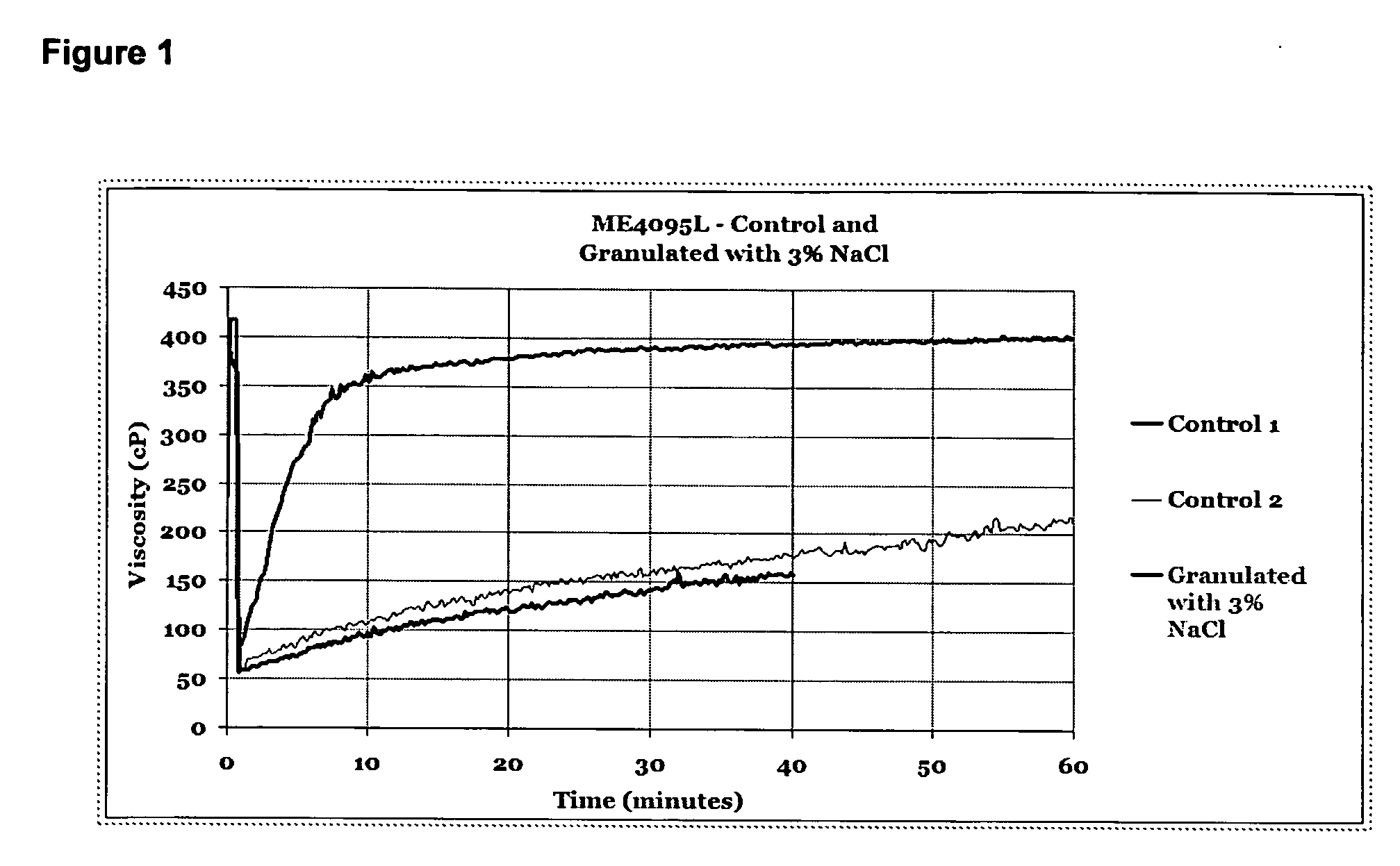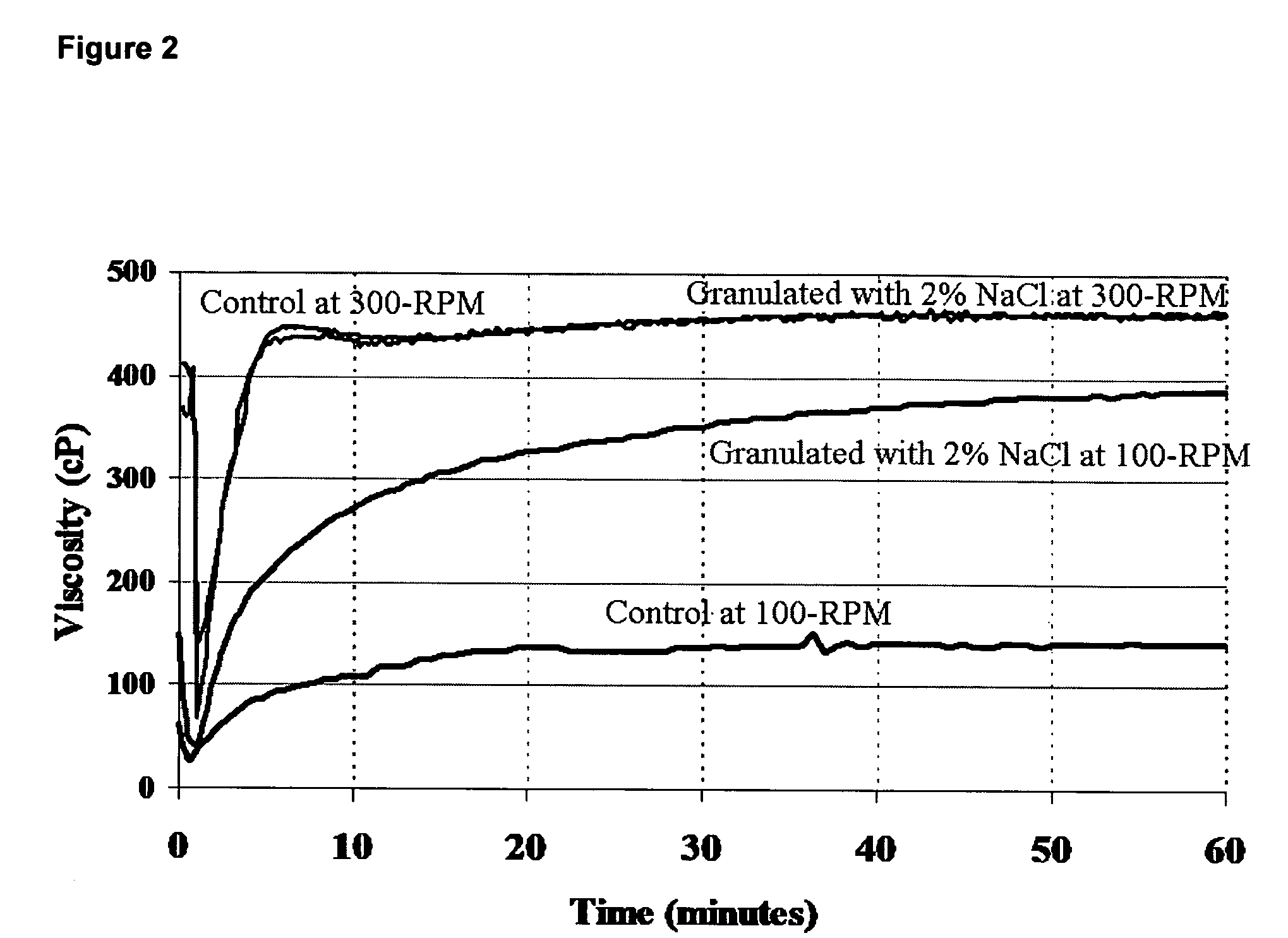Process of making cold-water dispersible cellulose ethers and uses thereof
a technology of cellulose ether and cold water dispersibility, which is applied in the direction of cellulose adhesives, adhesive types, coatings, etc., can solve the problems of affecting the hydration rate of cellulose ether, affecting so as to improve the dispersibility of cellulose ether. , the effect of good dispersion
- Summary
- Abstract
- Description
- Claims
- Application Information
AI Technical Summary
Benefits of technology
Problems solved by technology
Method used
Image
Examples
example 1
[0034]Several commercial water-soluble polymers were treated in a fluid bed dryer supplied by Glaft (Germany). Solid samples of polymer powder (1 batch ˜125 g) were placed in the MiniGlatt fluid bed dryer. Aqueous solutions containing various surface treatment additives were prepared separately and sprayed through a nozzle into the fluidized sample of the polymer using nitrogen as gas carrier. Temperature was varied in the range (30° C.-75° C.) and treatment time was anywhere between 20-60 minutes. Volume of solution added was 10% to 60% by weight compared to the weight of the initial water-soluble polymers sample.
TABLE 1SurfaceWater + SurfaceWater-SurfaceTreatmentTreatmentSolublePolymerWaterTreatmentAdditiveAdditive% WaterPolymer(grams)(grams)Additive(grams)(grams)addedMC12521.25NaCl3.752517.00HPC15082.4Lactose9.291.654.96HPC15071.4Na-caseinate7.979.347.57HPC15028.7NaCl1.530.219.113HPC15057.6NaCl14.472.038.40HPC15028.5Sugar1.530.019.00HPC15060.0Sugar15.075.040.00Guar15028.5KCl1.530...
example 2
[0036]Hydroxy Propyl Cellulose-HPC samples (Klucel® GF hydroxyl propyl cellulose, obtained from Hercules Incorporated) and their corresponding hydration times, additive type and percent are listed below in Table 2. All samples were prepared by the fluid bed approach as described in Example 1.
TABLE 2Time to 90% max. viscosity(min)Relative to ContolControl24.5N / AHPCControl19.31.3XHPC sieved (w / o fines)Control18.71.3XHPC water granExample 2a11.62.1XHPC with 3% lactoseExample 2b11.62.1XHPC with 1% NaClExample 2c9.82.5XHPC with 8.8% NaCl
[0037]In Example 2, samples of hydroxyl propyl cellulose were tested. In initial stage, (Klucel® EF hydroxyl propyl cellulose, available from Hercules Incorporated) (Mw ˜80,000)) was sieved through a 200 mesh screen and coarse sample retained. In is noted that removal of the fines from the sample through the sieving process resulted in an improvement in hydration time compared to the original sample. It is observed that removal of fines through the use of...
example 3
[0038]In Example 3, samples of cold water dispersable methyl hydroxyl ethyl cellulose MHEC (ME 4095L MHEC, available from Hercules Incorporated) were prepared by the fluid bed approach as described in Example 1 with NaCl as the surface treatment additive. Samples of the MHEC were tested before and after treatment with 3% NaCl using the fluid bed dryer. The dissolution curves were obtained using a Haake 550 Viscotester from Thermo Electron Corporation. These dissolution curves comprising hydration time and viscosity buildup are found in FIG. 1.
[0039]In Example 3, a dramatic improvement in methyl hydroxyl ethyl cellulose polymer hydration before and after treatment with 3% NaCl in fluid bed dryer was observed. Among the advantages of such an improvement is minimization of the energy expenditure and increase efficiency and throughput in the dispersion of the cold water dispersible water-soluble polymers into water.
PUM
| Property | Measurement | Unit |
|---|---|---|
| Temperature | aaaaa | aaaaa |
| Temperature | aaaaa | aaaaa |
| Temperature | aaaaa | aaaaa |
Abstract
Description
Claims
Application Information
 Login to View More
Login to View More - R&D
- Intellectual Property
- Life Sciences
- Materials
- Tech Scout
- Unparalleled Data Quality
- Higher Quality Content
- 60% Fewer Hallucinations
Browse by: Latest US Patents, China's latest patents, Technical Efficacy Thesaurus, Application Domain, Technology Topic, Popular Technical Reports.
© 2025 PatSnap. All rights reserved.Legal|Privacy policy|Modern Slavery Act Transparency Statement|Sitemap|About US| Contact US: help@patsnap.com


